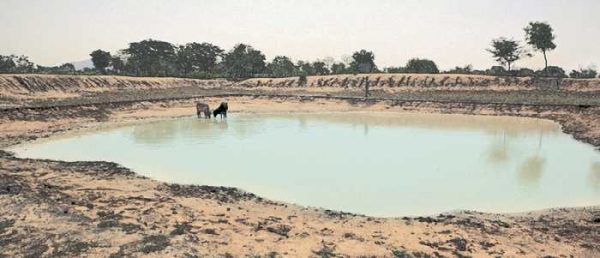
As the global climate crisis worsens, it is becoming clear that marginalised people and communities are most affected. Those living in rural areas generally have a low carbon footprint – especially compared to people in urban areas – and yet they are suffering from an exacerbation of already extreme environmental challenges.
Rolling barren hills of the Aravalli range define much of southern Rajasthan’s landscape. More than 70% of the land in Udaipur district is under state ownership and they provide families with food, fuel, and fodder for livestock. Known as ‘common lands’, these include village pastures, sacred groves, and village forests and are largely located on the upper ridges of hills.
A large majority of the families in this area are from tribal communities, and more than 80% of them rely on subsistence agriculture to survive.Private land is on an average less than one hectare, and the fodder produced on this land is not enough to meet the requirements for livestock, an important source of family income, thus highlighting the importance of well managed common land. Strong and diverse common land leads to more efficient and productive farming.
Common lands and communities have a symbiotic relationship. As much as the communities rely on the common land for their survival, the common land is equally reliant on the communities to flourish. With a lack of protection and management mechanisms, over time these lands have been left to degrade,and in many cases, have become barren. In Udaipur and Rajsamand districts, 67% of the land is undergoing rapid degradation and desertification. These lands areregularly a subject of contestation and privatisation within communitiesand from commercial parties. In some areas, 80% of common land has been encroached. This has been disastrous for the environment and is directly contributing to the destabilisation of the local environment.
Seva Mandir isworking closely and supporting over 300 rural and tribal communities in the region to aid the reclamation of their common lands, to remove encroachers and regenerate the local biodiversity. This issue is a matter of priority for the organisation, whichhas been working for more than three decades on this using a community-based approach. To bring the local people together on development agenda, regardless of caste, gender or religion,Village Institutions called Gram Samuhsare formed. These institutions are given the tools and knowledge to take control of and manage their common lands.
With the onset of the Covid-19 pandemic and the ensuing lockdown, some have attempted to take advantage of the situation to encroach on previously redeveloped common land to privatise it for their own benefit.
Situated in the heart of the Aravalli Mountain range, BheelokiTalai is home to just over 100 families – typical for villages in southern Rajasthan. The community were able to restore and develop the village’scommon land in 1990. Since then, the local ecology has bloomed, and the land is now an oasis of lush green flora amongst a sea of dry and barren land.
When the Covid-19 lockdown started, movement was restricted, which meant the community could not travel to theircommon land. Seeing this as an opportunity, one family decided to encroach onto the land for their own benefit. They cut off a section of the common land, making a boundary from thorny shrubs, and also began the construction of a small shed.
“The Covid-19 lockdown has changed many things in the village including the intentions of encroachers,” explains Kheta, President of BheelokiTalai’s Village Institution. “We cannot let go of the common land we have cared forfor so many years. It is now our responsibility to pass it on for future generations”
Even though people were not able to move, words still could. The community quickly became aware of the family’s illegal actions and the Village Institution immediately took action. Efforts were made to contact the family tohave a discussion on their encroachment and pressure them to vacate the land. The family ignored all requests.
Realising that the common land was facing a serious threat, the Village Institution decided to take action. Ensuring that social distancing norms were followed, the members of the institution removed the shrubs and dismantled the shed. The family, facing serious societal pressure, rescinded their claim on the land.
This story is not unique toBheelokiTalai; it has been seenin other villages of southern Rajasthan during the Covid-19 lockdown. Encroachers attempted to settle and take control of common land, assuming that the pandemic distracted the attention of the local communities.
Hari, member of BheelokiTalai’s Village Instutiton shares his community’s determination; “The common land is a huge support for many households during these difficult times. We will not let the pandemic change the way we take care of our resources”
As with BheelokiTalai, previously fragmented communities are now together, breaking down the historical divisions of caste, religion and gender, and they secured their common land, the resources it provides, and, ultimately,protected the environment.
With climate change disproportionately affecting marginalised people, community action is showing itself to be an effective method of protection and restoring fragile environments.
Working with the rural and tribal communities also means giving them a platform to speak. They have been the traditional keepers of these common lands for centuries; they have the knowledge on how to protect them, and their value in providing sustainable resources to rural communities. They are the best protectors of their environment.

